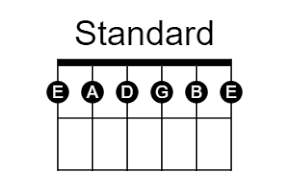One of the most important elements of playing the guitar is learning how to tune your instrument. Even the most beautiful song or melody can sound bad on an out-of-tune guitar, while a perfectly tuned guitar’s sound is pleasing to the ears. Besides, tuning your guitar guarantees that each string you play produces the right note while creating a harmonious sound. If you are an aspiring guitarist, you need to know how to tune your instrument and also be familiar with the different ways to tune your guitar.

Guitar can be tuned manually by ear or with the help of an electronic tuner. In this post, we’ll go over the different ways to tune your guitar and we’ll also offer some advice on how to develop your ear for tuning.
Why Tune Your guitar?
Before we dive into the different methods of tuning a guitar, let’s discuss why tuning is so important. Tuning your instrument ensures that each string is in the correct pitch. When you play the chords, they will sound clean and clear, and every single note will ring out properly. There might be instances where you will be playing with other musicians. Therefore, it is essential that everyone’s instrument is in tune with each other. If your guitar is even slightly out of tune, the whole band will sound bad.
Standard Tuning
The most common tuning for a guitar is standard tuning. Standard tuning is the regular tuning used on most guitars and is also the tuning that most beginner guitarists learn. Standard tuning consists of the following notes E-A-D-G-B-E, starting with the thickest string (low E) and ending with the thinnest string (high E). Standard tuning is used as it provides a simple fingering (fret-hand movement) for playing all the standard scales and basic chords in all minor and major keys.

There are also alternative tunings but this can be done when a guitarist is at a much higher level than a beginner.
How to Tune Your Guitar – Different Methods
The first thing you should do every time you pick up a guitar is make sure it is in tune. Tuning takes only a few minutes and significantly improves the way your instrument sounds.
An out-of-tune guitar can be particularly frustrating especially if you’re just learning to play because every note will sound wrong. Moreover, learning guitar becomes more challenging because you will fail to hit the right notes when your instrument is out of tune. Thus, you should know how to tune your guitar correctly to always sound your best.
Tuning by Ear
Tuning by ear is a skill that takes time and practice to develop. This is a valuable skill to have as a musician. In order to tune by ear, you have to know the sound of each string when it is in tune. However, when you are tuning it’s better and easier to use a reference pitch. You can use a tuning audio file, a piano, pitch pipe, or even an app to hear each note and adjust the sound of your guitar strings. As you play each note, turn the tuning pegs until your guitar strings exactly match the pitch.
Another way to tune by ear is to use harmonics. Generally, harmonics are created when you slightly touch the string over a certain fret (5th fret). Note, you are not pressing down on the string.
To tune using harmonics, start by hitting the strings when your finger gently touches the fifth fret of the low E string. You will get the same pitch as the open A string. Now, play the A string and adjust the tuning peg until the two pitches match. Continue this process, using the fifth fret harmonic on each string except for the G string, which uses the fourth fret harmonic. Once you land on the high E string, you can use the fifth fret harmonic on the B string to match the high E.
Tuning With a Tuner or an App
The easiest way to tune a guitar is by using an electronic tuner. Tuners are available for purchase as standalone units from different brands. There are also tuner apps for smartphones and tablets.
To tune the guitar using a tuner, you will simply pluck the string and observe the tuner’s display. In the display you will see whether the string is flat, sharp, or in tune. Use the tuning pegs to adjust the pitch until the tuner indicates that the string is in tune. You will have to repeat this process for each string.
Guitar Tuna App Tutorial
This app is the most popular and a free tuner app that musicians use to tune their guitars. You can download the app and use it as well.
| The strings on your guitar need to be tuned in order for it to sound amazing. However, if you are a complete beginner, the following is a simple step by step guide to tune your guitar using the GuitarTuna app. Before we start with the tuning you must know that there are 6 strings on your guitar ranging in their thickness.
You will need the “GuitarTuna” app to tune your guitar. (Do not purchase the app. The free version has the tuning feature.) *Select guitar as the instrument of choice. Go to the home screen. What you see on the screen is the head of the guitar, as shown in the image. Meanwhile, on your guitar, look for the tuning pegs and get a hold of it.
Trial Check Each time you hit any string on your guitar and if it is tuned correctly the marker will go green! If the notes are off, you can tune it by following the instructions given below. Steps of Tuning the Guitar on the App (shown for the 6th string)
If the Marker says, “Too Low/Tune Up” slowly turn the tuning peg anti-clockwise until the marker goes green!
If the Marker says, “Too High/Tune Down” slowly turn the tuning peg clockwise until the marker goes green!
The 5th and the 4th string can be tuned similarly. Steps of Tuning the Guitar on the App (shown for the 1st string)
Note: The tuning direction reverses for 1st, 2nd and 3rd string. If the Marker says, “Too Low/Tune Up” slowly turn its tuning peg clockwise until the marker goes green!
If the Marker says “Too High/Tune Down” slowly turn its tuning peg anti-clockwise until the marker goes green!
The 2nd and the 3rd string can be tuned the exact way. |
Tuning With a Pitch Pipe
What is a pitch pipe? Well, it is a small device that produces a tone when you blow into it. This is also a useful tool for tuning your instrument. You can use a pitch pipe to refer to the pitch and tune the guitar accordingly. Simply blow into the device and match the tone to the corresponding string. Adjust the tuning pegs until the tone of the string matches the pitch of the pitch pipe.

Tuning With Harmonics and Digital Tuner
As mentioned earlier, tuning with harmonics is a great way to tune your guitar by ear. However, you can also use harmonics to tune your guitar with an electronic tuner. To do this, play a harmonic on the fifth fret of the low E string and observe the tuner’s display. Adjust the tuning pegs until the tuner indicates that the string is in tune. Repeat this process for each string.
Tips for Tuning Your Guitar
- How often should I tune my guitar? The answer is every time you play it. Yes, we know that you have recently tuned your guitar and it was in tune the last time you played it. However, changes in temperature, humidity, and other factors can cause the guitar to go out of tune. Always check the tuning once and ensure that your guitar always sounds perfect.
- Take the low E string first: When you sit down to tune your guitar, it is best to start with the low E string and then work your way up to the high E string. The low E string can be the reference point for the rest of the strings.
- Tune up to the note: During the tuning process, you should primarily tune up to the note, rather than tuning down. This means that if a string is flat (low), you should tune up to the correct pitch instead of tuning down and then back up again.
- Develop and use your ears: A digital tuner has made it so convenient to tune your guitar. Nonetheless, it is important to develop your ear for tuning. Why we say this is because tuning by ear will help you quickly identify if your guitar is out of tune and correct it. Besides, having a good ear (pitch recognition) will make you a better musician overall.
- Be gentle: Remember, guitar strings can break if the tension is too much, especially the thinner ones. When you are tuning your guitar, you have to be gentle while turning the tuning pegs. Over-tightening the strings can cause them to break, while excessive force can also damage the tuning pegs or the guitar itself in the long run.
Conclusion
Guitar tuning is nothing but the assignment of pitches to the open strings of guitars. As per the general convention, the notes are ordered and arranged from the thickest string to thinnest or the lowest-pitched string to the highest-pitched string.
In any case, by using the different ways to tune your guitar outlined in this article, you can ensure that your guitar always sounds its best. Whether you choose to tune by ear, with a tuner, or using harmonics, it is important to tune often and develop your ear for tuning. Remember to start with the low E string, tune up to the note, and be gentle with the tuning pegs. With practice and patience, you will be able to tune your guitar like a pro.
Learning music has never been easier thanks to the flexible online guitar classes at Music Pandit. Reach out to the team or visit our website to know more. We are always here to help your child become the best they can be!





















1 comment
This is the right blog for everyone who wants to find out about this topic. You understand so much its almost hard to argue with you (not that I personally would want toÖHaHa). You certainly put a new spin on a topic thats been written about for decades. Wonderful stuff, just great!
Comments are closed.